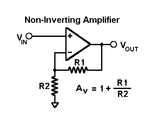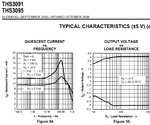Politecnico
Member level 1

Hi guys

In a non-inverting op-amp, Vout=(1+R1/R2)Vin. Assuming Vsupply=±Vcc, Vout is supposed to swing up to ±Vcc
(Right?). While that's ideal and I don't expect Vout reaches ±Vcc; the Vout I see in the simulation, saturates far before ±Vcc.
Here are the parameters (exactly according to the datasheet):
op-amp: THS3091
R1=1000 Ω
R2=250 Ω
Vsupply=±5v
Vin=1 Vp-p sine wave @ 1 MHz
while Vout should be 5 Vp-p, it saturates at around 3 Vp-p. (As a solution, I could change the Vsupply=±5v to ±8v to have non-saturated output. But, increasing the Vsupply in the design is not allowed)
Here is the question:
Is this early saturation at 3v inevitable OR I am doing some mistakes in this simple design?
Thanks a lot, in advance
Politecnico

In a non-inverting op-amp, Vout=(1+R1/R2)Vin. Assuming Vsupply=±Vcc, Vout is supposed to swing up to ±Vcc
(Right?). While that's ideal and I don't expect Vout reaches ±Vcc; the Vout I see in the simulation, saturates far before ±Vcc.
Here are the parameters (exactly according to the datasheet):
op-amp: THS3091
R1=1000 Ω
R2=250 Ω
Vsupply=±5v
Vin=1 Vp-p sine wave @ 1 MHz
while Vout should be 5 Vp-p, it saturates at around 3 Vp-p. (As a solution, I could change the Vsupply=±5v to ±8v to have non-saturated output. But, increasing the Vsupply in the design is not allowed)
Here is the question:
Is this early saturation at 3v inevitable OR I am doing some mistakes in this simple design?
Thanks a lot, in advance
Politecnico
Last edited:


